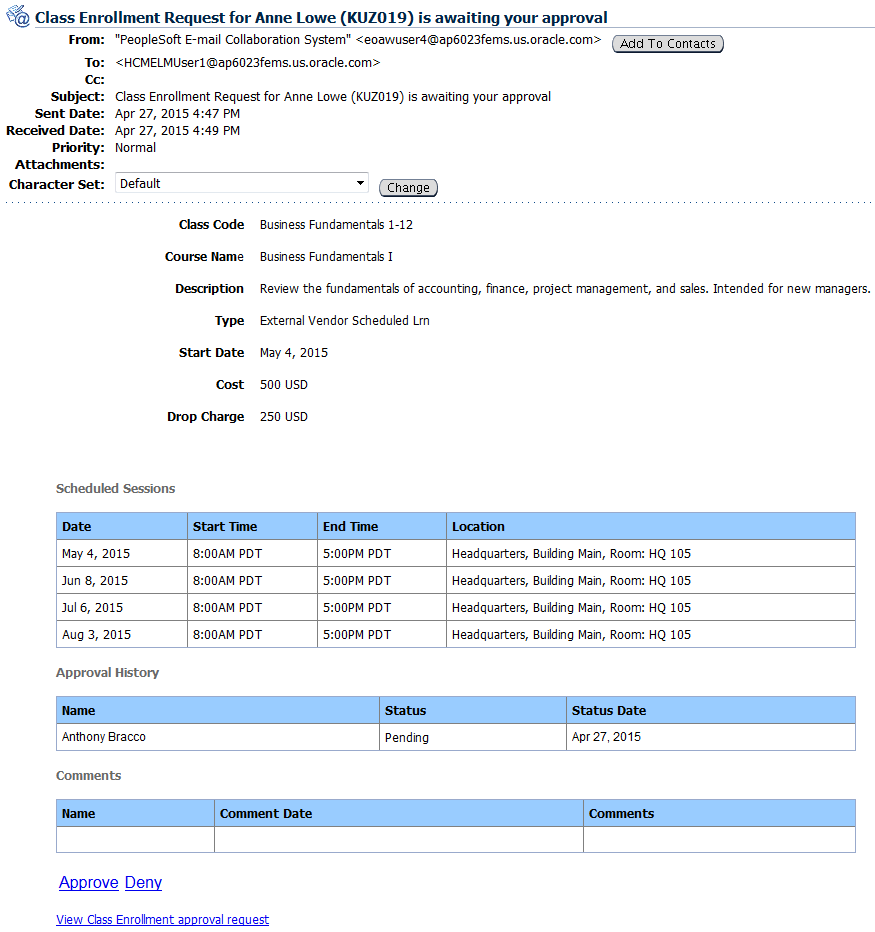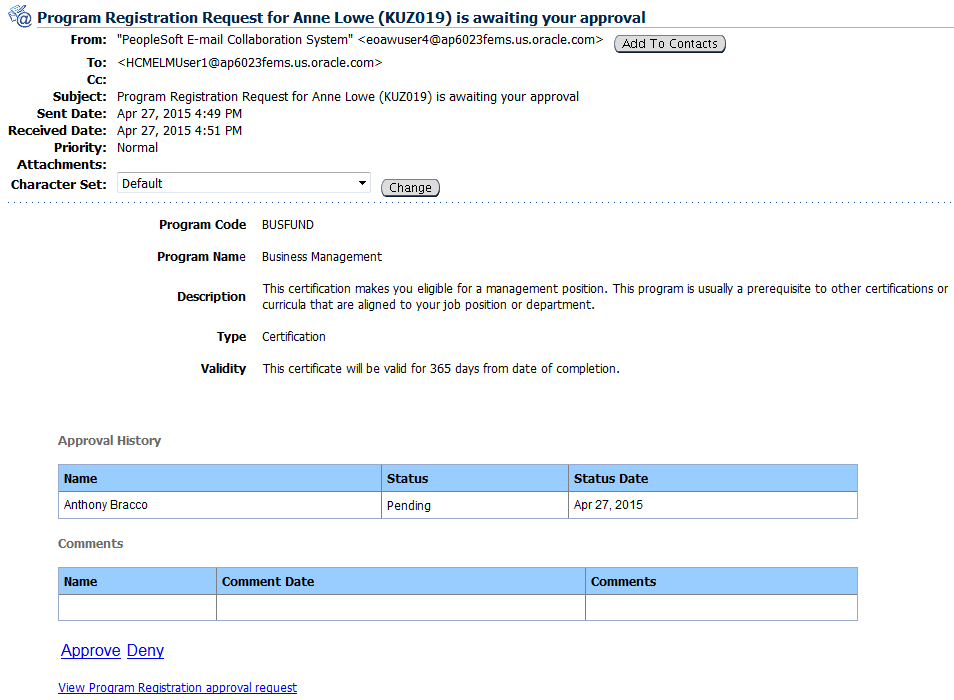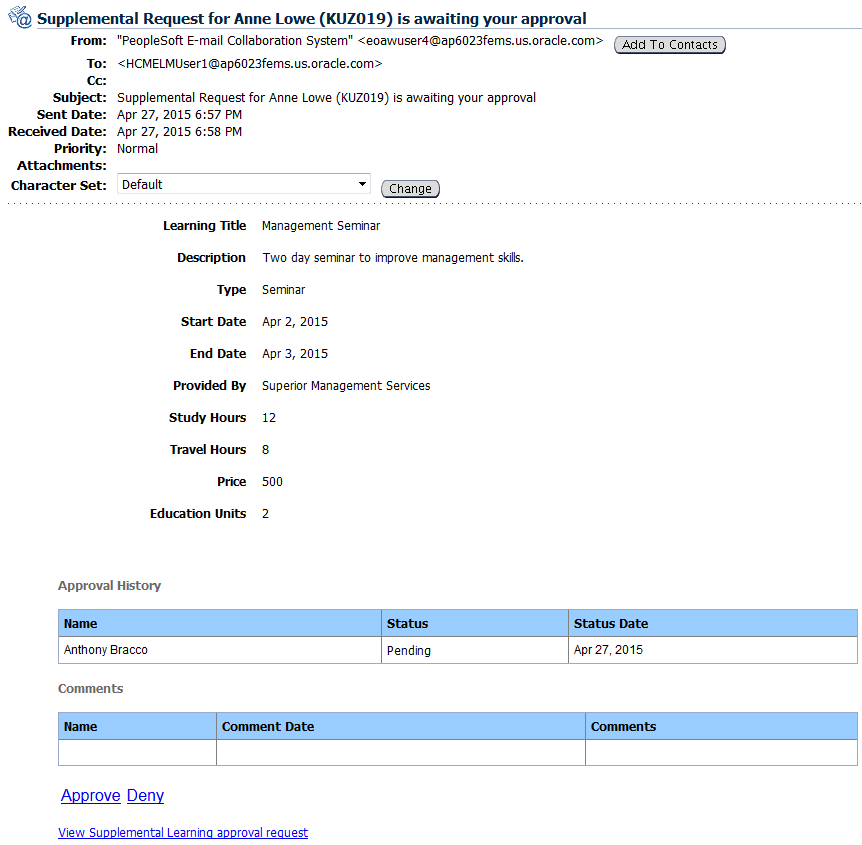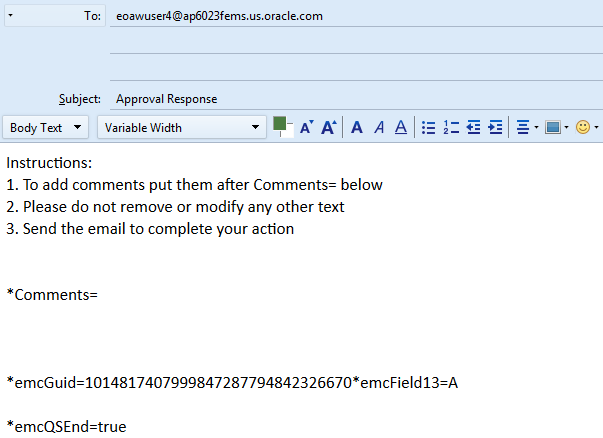Using HTML Email Approvals with ELM Transactions
The PeopleSoft Approval Framework enables you to take action on approval requests directly from an email (for example, approve, deny, or pushback).
The HTML Email Approval feature delivers HTML email templates for key PeopleSoft Enterprise Learning Management transactions. This table lists these transactions along with their corresponding process IDs:
|
Transaction |
Transaction Process IDs |
|---|---|
|
Class Enrollment |
|
|
Program Registration |
|
|
Supplemental Learning |
|
Note: This feature is dependent on the Approvals Framework delivered by Enterprise Components. For more information on setting up the Approval Framework for PeopleSoft ELM, see Understanding the Approval Framework.
Configuring HTML Email Approvals
The Approval Framework supports HTML email approvals as delivered. However, after the framework is enabled, you need to perform the following steps to ensure that your system uses this functionality according to your business needs:
Use the URL Maintenance Page to define the URL of the application server associated with the HTML_EMAIL_APPROVAL URL identifier.
Select the Use Email Approvals check box on the Register Transactions Page to enable HTML email approvals for the process IDs associated with your ELM transactions.
Use the Edit Template button on the Configure Transactions Page to review the template associated with a process ID and, if necessary, modify it to meet your business requirements.
Set up the EOAWEMC Application Engine process to run periodically to process the approval action emails sent by approvers.
The EOAWEMC process updates the approval status for the approver(s) and routes the approval request to the next person in the approval chain, if applicable. We recommend that you add a recurrence to the process to have it run as often as necessary so that approval responses are handled in a timely manner. For more information on the EOAWEMC process, see Scheduling the Application Engine Program EOAWEMC.
For each transaction submitted for approval, the system generates an email and sends it to the appropriate approver. The email contains detailed information about the transaction request. An approver can take action directly from the email by clicking a link, such as Approve, Deny, or Pushback, to generate a reply to the request. The email displays requestor comments and approval history. In addition, if the approver needs further details or information, the email provides a link that enables her to view the approval request in PIA.
This is an example of an HTML approval email for a class enrollment.

This is an example of an HTML approval email for a program registration.

This is an example of an HTML approval email for a supplemental learning request.

Information Displayed for Classroom Enrollment Approval Emails
The summary section of the email displays the following information for the class:
|
Field |
Derived From |
|---|---|
|
Class Code |
Class Code field on the Maintain Classes - Class Details Page |
|
Course Name |
Course Long Name field on the Course Details: Basic Data Page |
|
Description |
Description field on the Course Details: Basic Data Page |
|
Type (delivery method) |
Delivery Method field on the Maintain Classes - Class Details Page |
|
Start Date |
|
|
End Date |
The End Date field on the Maintain Classes - Class Details Page |
|
Duration |
Days, Hours, and Minutes fields on the Maintain Classes - Class Details Page |
|
Cost |
For internal learners, Internal Price field For external learners, External Price field Currency derived from the Currency field All three fields are located on the Maintain Classes - Class Details Page. |
|
Drop Charge |
For internal learners, Internal Price Drop field For external learners, External Price Drop field Currency derived from the Currency field All three fields are located on the Maintain Classes - Class Details Page. |
Note: If any of these parameters are not defined for a class, they are not displayed in the email. For more information on defining class details, see Understanding Management of Classes.
The Scheduled Sessions grid lists all of the scheduled sessions for the class being requested. For each session, the page displays:
|
Field |
Derived From |
|---|---|
|
Start Date |
Date field defined on the Session Details Page. |
|
Start Time |
Start Time field defined on the Session Details Page. |
|
End Time |
End Time field defined on the Session Details Page. |
|
Location |
Combines the following three fields, concatenated:
|
If there are no scheduled sessions for the class being requested, this section does not appear on the page. For more information on scheduling sessions, see Understanding Sessions, Webcasts, and Assignments.
Information Displayed for Program Registration Approval Emails
The summary section of the email displays the following information for the program:
|
Field |
Derived From |
|---|---|
|
Program Code |
Certification Code or Curriculum Code field on the Maintain Programs - Details Page |
|
Program Name |
Long Name field on the Maintain Programs - Details Page |
|
Description |
Description field on the Maintain Programs - Details Page |
|
Type (Certification or Curriculum) |
Program type selected when the program is created |
|
Validity |
Validity Period field on the Maintain Programs - Details Page Note: The Validity field appears only for certifications that have a validity period defined. |
For more information about defining program details, see Defining Programs.
Information Displayed for Supplemental Learning Approval Emails
The summary section of the email can display the following information for the supplemental learning:
Title
Description
Start Date
End Date
Institution
Location
Provided By
Supervised By
Travel Hours
Study Hours
Currency Code
Education Units
Price
Free Field One
Free Field Two
Free Field Three
Free Field Four
Instructions
All of these fields are derived from their counterpart on the Supplemental Learning: General Attributes Page. A field appears in the email only if both of the following are true:
The field is defined for the supplemental learning.
The Display check box is selected for the field on the Define Supplemental Learning - Details Page.
For more information on supplemental learning, see Understanding Supplemental Learning.
Approval History Grid
This grid appears for all ELM transactions. It displays the name of the current approver with a status of Pending. It also lists approvers that have already responded to the transaction. This grid does not show the approval chain, which consists of approvers that are in the queue to approve.
Comments Grid
This grid appears for all ELM transactions. displays any comments entered by approvers.
Responding to an Approval Request
The approver can act upon an approval request by selecting the appropriate action link that appears at the bottom of the email: Approve, Deny, or Pushback.
Upon selecting an action, a response email opens in the approver’s default email client. The email includes text to instruct the approver where to enter any comments.
Note: The Push Back link does not appear for first-level approvers.
This is an example of an email that is generated when you click an action link in an HTML approval email.

The approver can enter comments after the Comments text, but this is not a requirement.
Note: Approvers should not remove or modify any other identifiers or text from the response email.
After the approver sends the response email, the system updates the approval status of the associated request the next time it runs the EOAWEMC Application Engine process.